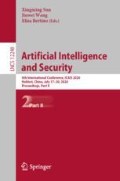Abstract
As an efficient data analysis tool, data mining can discover the potential association and regularity of massive data, and it has been widely used and played an important role in business decision, medical research and so on. However, the data mining technology is also a double-edged sword, in bringing convenience at the same time, will also cause the user’s privacy leak problem. In order to solve the problem, the symmetric searchable encryption technology is introduced into the association rule mining system to protect the privacy, and privacy preserving mining system of s (PP-MSAR) in OpenStack-based Cloud environment is designed. In order to solve the problem that the existing data mining algorithms can’t deal with large-scale data, this paper uses the computational power of Hadoop platform and add the global pruning technique to the existing algorithm based on MapReduce association rules, so that the counting of frequent item sets get reduced. At the same time, this paper add frequent matrix storage method into the distributed association rules algorithm and realize he algorithm of mining association rules for frequent matrix storage based on MapReduce. In addition, the introduction of symmetric searchable encryption technology to support the cloud server-side ciphertext retrieval, on the one hand to ensure that users stored in the database information will not be leaked to the outside for others, on the other hand also to ensure that the user data for the system staff confidential. Finally, we test the system, and the results show that the system can carry out association rules mining under the premise of protecting user privacy, and provide the correlation degree between data, which has certain practical significance and application value.
Access this chapter
Tax calculation will be finalised at checkout
Purchases are for personal use only
References
Xu, J., Jiang, Z.H., Wang, A.D., Wang, C., Zhou, F.C.: Dynamic proofs of retrievability based on partitioning-based square root oblivious RAM. Comput. Mater. Continua 57(3), 589–602 (2018)
Hsu, I.C.: XML-based information fusion architecture based on cloud computing ecosystem. Comput. Mater. Continua 61(3), 929–950 (2019)
Xu, J., Wei, L.W., Wu, W., Wang, A.D., Zhou, F.C.: Privacy-preserving data integrity verification by using lightweight streaming authenticated data structures for healthcare cyber-physical system. Future Gener. Comput. Syst. (2018). https://doi.org/10.1016/j.future.2018.04.018
Wang, C., Liu, M.J.: Dynamic trust model based on service recommendation in big data. Comput. Mater. Continua 58(3), 845–857 (2019)
Dey, L., Mukhopadhyay, A.: Biclustering-based association rule mining approach for predicting cancer-associated protein interactions. IET Syst. Biol. 13(5), 234–242 (2019)
Rekik, R., Kallel, I., Casillas, J., Alimi, A.M.: Assessing web sites quality: a systematic literature review by text and association rules mining. Int. J. Inf. Manag. 38(1), 201–216 (2018)
Aghaeipoor, F., Eftekhari, M.: EEFR-R: extracting effective fuzzy rules for regression problems, through the cooperation of association rule mining concepts and evolutionary algorithms. Soft. Comput. 23(22), 11737–11757 (2019). https://doi.org/10.1007/s00500-018-03726-1
Yedjour, D., Benyettou, A.: Symbolic interpretation of artificial neural networks based on multiobjective genetic algorithms and association rules mining. Appl. Soft Comput. 72, 177–188 (2018)
Agrawal, R., Srikant, R.: Fast algorithms for mining association rules in large databases. In: The 20th International Conference on Very Large Data Bases, p. 487. Morgan Kaufmann Publ Inc. (1994)
Agrawal, R., Imielinski, T., Swanmi, A.: Mining association rules between set of items in large databases. ACM SIGMOD Rec. 22(2), 207–216 (1993)
Author information
Authors and Affiliations
Corresponding author
Editor information
Editors and Affiliations
Rights and permissions
Copyright information
© 2020 Springer Nature Switzerland AG
About this paper
Cite this paper
Zhang, Z. et al. (2020). Privacy Preserving Mining System of Association Rules in OpenStack-Based Cloud. In: Sun, X., Wang, J., Bertino, E. (eds) Artificial Intelligence and Security. ICAIS 2020. Lecture Notes in Computer Science(), vol 12240. Springer, Cham. https://doi.org/10.1007/978-3-030-57881-7_19
Download citation
DOI: https://doi.org/10.1007/978-3-030-57881-7_19
Published:
Publisher Name: Springer, Cham
Print ISBN: 978-3-030-57880-0
Online ISBN: 978-3-030-57881-7
eBook Packages: Computer ScienceComputer Science (R0)

